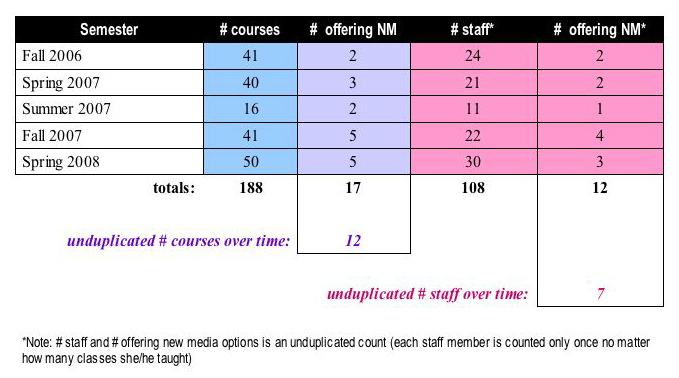



An unduplicated count
I also performed an unduplicated count of courses and instructors to derive a better sense of the new media composition opportunities available. Over the specified time period (Fall 2006 – Spring 2008), only 12 discrete courses offered digital composition options according to the syllabi (lower than the original count of 17 because courses were offered repeatedly over the years studied). Similarly, in an unduplicated count, the number of different staff members explicitly announcing on their syllabi their willingness to accept new media compositions dropped to seven.

During one of the interviews, a graduate student noted that she only recalled having the option to engage in digital composition when the courses specifically dealt with new media topics. As a result, I returned to the data to examine course titles and the topics covered. Of the 12 unduplicated courses offering new media options, over half were indeed new-media related (either revolving entirely around the subject or covering it as part of survey-course structure). Of those same 12 courses, seven also could be considered “production” courses specifically focused on producing specific types of genres/products — although not the same seven courses identified as new-media related.
Again, these data appear similar to findings in other studies. According to Anderson et al who conducted a survey of 45 faculty members and graduate students representing 25 college and universities:
Eighty-four percent of respondents (n=37) indicated that multimodality was taught on an “individual teacher basis” while only 32 percent reported that multimodality was taught in specific courses (rather than by specific teachers). On both undergraduate and graduate programmatic levels, 24 percent of respondents (n=9 in both cases, although not the same 9 respondents in each case0 indicated that multimodality was emphasized as part of the curricula, and 21 percent (n=8) indicated that multimodality was implemented in general education sequences (2006, 69).
Keeping in mind that survey data from Anderson et al are not limited to graduate classrooms, the numbers are similar to those collected for the Old Dominion University sample where options for new media assignments (multimodality in practice) are confined to a discrete number of courses and staff members.
New media opportunities • An unduplicated count • Unequal opportunities • Implications • Home